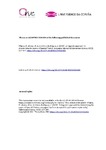Mostrar o rexistro simple do ítem
A linguistic approach for determining the topics of Spanish Twitter messages
| dc.contributor.author | Vilares, David | |
| dc.contributor.author | Alonso, Miguel A. | |
| dc.contributor.author | Gómez-Rodríguez, Carlos | |
| dc.date.accessioned | 2024-01-18T15:53:17Z | |
| dc.date.available | 2024-01-18T15:53:17Z | |
| dc.date.issued | 2015 | |
| dc.identifier.citation | Vilares, D., Alonso, M. A., & Gómez-Rodríguez, C. (2015). A linguistic approach for determining the topics of Spanish Twitter messages. Journal of Information Science, 41(2), 127-145. https://doi.org/10.1177/0165551514561652 | es_ES |
| dc.identifier.issn | 0165-5515 | |
| dc.identifier.issn | 1741-6485 | |
| dc.identifier.uri | http://hdl.handle.net/2183/34987 | |
| dc.description | This manuscript version is made available under the CC-BY-NC-ND 4.0 license https://creativecommons.org/licenses/by-nc-nd/4.0/. This version of the article: Vilares, D., Alonso, M. A., & Gómez-Rodríguez, C. (2015). ‘A linguistic approach for determining the topics of Spanish Twitter messages’ has been accepted for publication in Journal of Information Science, 41(2), 127-145. Copyright © 2014 The Authors. DOI: https://doi.org/10.1177/0165551514561652. | es_ES |
| dc.description.abstract | [Abstract]: The vast number of opinions and reviews provided in Twitter is helpful in order to make interesting findings about a given industry, but given the huge number of messages published every day, it is important to detect the relevant ones. In this respect, the Twitter search functionality is not a practical tool when we want to poll messages dealing with a given set of general topics. This article presents an approach to classify Twitter messages into various topics. We tackle the problem from a linguistic angle, taking into account part-of-speech, syntactic and semantic information, showing how language processing techniques should be adapted to deal with the informal language present in Twitter messages. The TASS 2013 General corpus, a collection of tweets that has been specifically annotated to perform text analytics tasks, is used as the dataset in our evaluation framework. We carry out a wide range of experiments to determine which kinds of linguistic information have the greatest impact on this task and how they should be combined in order to obtain the best-performing system. The results lead us to conclude that relating features by means of contextual information adds complementary knowledge over pure lexical models, making it possible to outperform them on standard metrics for multilabel classification tasks. | es_ES |
| dc.description.sponsorship | The research reported in this article was partially funded by Ministerio de Economía y Competitividad and FEDER (grant TIN2010-18552-C03-02), Ministerio de Educación, Cultura y Deporte (FPU13/01180) and by Xunta de Galicia (Grants CN2012/008, CN2012/319). | es_ES |
| dc.description.sponsorship | Xunta de Galicia; CN2012/008 | es_ES |
| dc.description.sponsorship | Xunta de Galicia; CN2012/319 | es_ES |
| dc.language.iso | eng | es_ES |
| dc.publisher | SAGE Publications & CILIP | es_ES |
| dc.relation | info:eu-repo/grantAgreement/MICINN/Plan Nacional de I+D+i 2008-2011/TIN2010-18552-C03-02/ES/ANALISIS DE TEXTOS Y RECUPERACION DE INFORMACION PARA LA MINERIA DE OPINIONES: ANALISIS DE ENUNCIADOS Y EXTRACCION DE RELACIONES | es_ES |
| dc.relation | info:eu-repo/grantAgreement/MECD/Plan Estatal de Investigación Científica y Técnica y de Innovación 2013-2016/FPU13%2F01180/ES/ | es_ES |
| dc.relation.isversionof | https://doi.org/10.1177/0165551514561652 | |
| dc.relation.uri | https://doi.org/10.1177/0165551514561652 | es_ES |
| dc.rights | Atribución-NoComercial-SinDerivadas 4.0 Internacional | es_ES |
| dc.rights.uri | http://creativecommons.org/licenses/by-nc-nd/3.0/es/ | * |
| dc.subject | es_ES | |
| dc.subject | Natural language processing | es_ES |
| dc.subject | Multi-label topic classification | es_ES |
| dc.title | A linguistic approach for determining the topics of Spanish Twitter messages | es_ES |
| dc.type | info:eu-repo/semantics/article | es_ES |
| dc.rights.access | info:eu-repo/semantics/openAccess | es_ES |
| UDC.journalTitle | Journal of Information Science | es_ES |
| UDC.volume | 41 | es_ES |
| UDC.issue | 2 | es_ES |
| UDC.startPage | 127 | es_ES |
| UDC.endPage | 145 | es_ES |
| dc.identifier.doi | 10.1177/0165551514561652 |
Ficheiros no ítem
Este ítem aparece na(s) seguinte(s) colección(s)
-
GI-LYS - Artigos [51]






